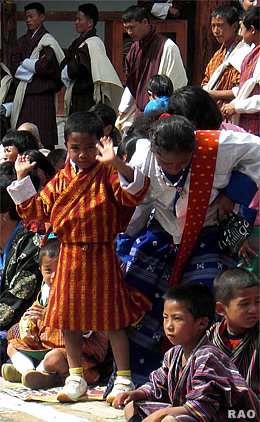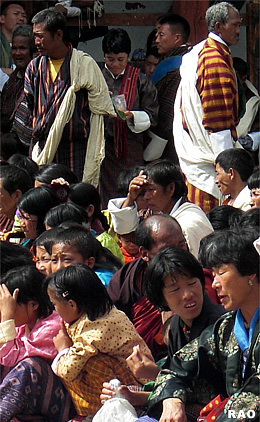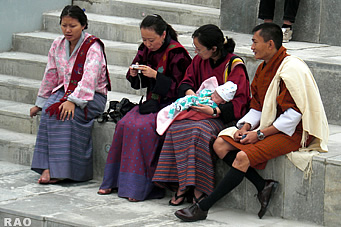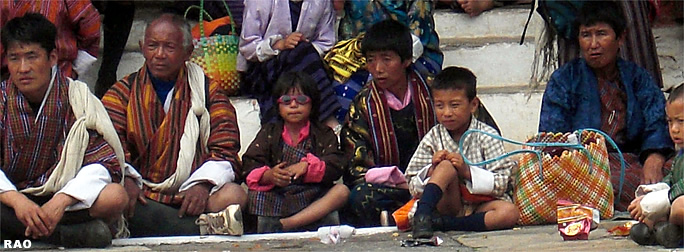|
A
tradition under change: Marriage in Estern Bhutan
|
 |
Bhutan's
People |
|
 |
Bhutan's
People |
|
|
|
 |
|
Serga
mathang and serga khothkin in Eastern Bhutan
|
 |
 |
| Type
of Cross Cousin Marriages |
Matrilateral
Cousin Marriage
A
man marries his mother's brother's daughter. The kinship term given to
maternal uncle's daughter is serga mathang. A mother's brother is termed
as serga ajang.
Patrilateral
Cousin Marriage
This
is another common marital tradition in which a man marries his father's
sister's daughter. A daughter of paternal aunty is again termed as serga
mathang and her mother as serga ani (golden aunty). A jocular Bhutanese
saying, "a nephew can claim all his golden aunt's daughters even if the
number is hundred", suggest wryly that matrilateral cross cousin marriages
are not unusual, especially in eastern and central Bhutan.
Bilateral
Cross Cousin Marriage
Bilateral
cross cousin marriages are not as common as patrilateral or matrilateral
cross cousin marriages. It occurs only in certain social situation of arranged
marriages where two men marry each other's sister. Such marital relationship
is common in societies of Brokpa and Dakpa.
Parallel
Cousin Marriage
Parallel
cousins, the children of two same sex siblings, are treated as one's own
brother or sister in Tsangla kinship structure. The parallel cousins are
termed as ata or kota (brother) and ana or usa (sister). |
|
top
|
Why
Cross Cousin Marriage?
|
 |
The
positive aspects of marrying one's own cross cousins are what keeps this
practice going on. The majority of illiterate people have a notion that
marrying outside their community is not an ideal norm. Unlike a community
where exogamy is favoured, kinship in Tsangla group is so intertwined due
to internal marriages.
It is said that almost all the people in a village
bears consanguineous relation both through lineage and marriage alliances,
enhancing their feeling of oneness and social unity. There is also another
rule that channels individuals into marriages within particular groups.
For example, in a remote village in southern Trashigang, there is chungnyen
which is a symbolic engagement between cross cousins in their childhood.
After their symbolic engagement, the level of social cooperation between
the two families get widened.
People
are well aware of economic advantages involved in consanguineous marriages.
A restriction of marriages within close relatives, such as first cousins,
avoids family property from going outside their own circle. It has ensured
the transmission of land and property from parents to their children, which
would otherwise be fragmented. However, this does not happen all the time.
If a land or property is to be exclusively bequeathed to their children
without fragmentation, then cousin couples must inherit the properties
from their respective parents.
The parental property is not necessarily
bequeathed to the children who are married to their consanguineously related
kin. This is the case when one of the two parents of a cousin couple chooses
to leave their property to one of their sons or daughters who is married
to an outsider. Thus, marriages among children of brother and sister do
not guarantee the continuity of keeping the inheritance within the relations.
Nonetheless, this marriage is common in the pastoral societies of Brokpa
and Dakpa to maintain integrity of family herds and is a motive to concentrate
property and personnel within narrow groupings.
A
cross-cousin marriage enriches the emotional lives and cultural experiences
of the people. A brother and sister may have emotional attachment to one
another since they are siblings of the same parents "sharing same blood
and bone". On the other hand, despite their attachment to each other as
brother and sister, they can become isolated as independent families as
soon as they get married and receive their parental share of resources.
Their affections for each other won't be as strong as when they were living
together with their parents in earlier parts of their life. The emotional
bonding to each other can be enhanced through marriages of their children
to one another. Through marital relinking of their children, the ties and
understanding between families are intensified; each family renders support
to other in times of need and urgency.
top
| Genetic
Debate Scientifically |
 |
 |
 |
| In
order to avoid marital discontentment, the parents usually initiate cross
cousin marriages among their children. Most of them are skeptical about
their children marrying strangers, or someone who belong to different social
groups in distant regions. They believe that somebody who belongs to their
own group is a best mate for their son or daughter because they have substantial
knowledge about him or her as potential spouse of their child. The character,
property status and family situation of their prospective bride or groom
would be known before actual marriage is proposed and arranged. People
from Gomdar, for example, are particular about their social structure.
Their
children are not married into inferior families. Families' status is differentiated
according to "bone quality". They believe that some people possess
good bones. Bagi khang (forehead bone), dhon khang (banshee bone),
nongshing khang (langur bone) and rolong khang (zombie bone) are some of categories that ambiguously differentiate people in those places.
It is also believed that women of dhon khang are unusually beautiful. |
|
An
egoist view of their extreme loveliness is revealed by saying, "even if
my bone is not equivalent to yours, my beauty can make me equal to you".
This is an expression a beautiful woman uses when she is unable to marry
a man from higher strata. Thus, another probable reason for discouraging
marriages with outsiders.
Each
normal person is said to possess twenty or more potentially defective genes.
There is an equal number of healthy genes that represses the function of
bad genes. These abnormal genes remain inactive under normal circumstances.
Cousins are expected to have the same genes passed down to them from their
common ancestors.
A cross cousin marriage increases the chance of these
bad genes getting paired in their offspring. A combination of potentially
bad genes inherited by married cousins means unhealthy trait in a child.
Pairing up of good genes in an offspring of married cousins may result
in good traits and health but not as good as those of unrelated couples.
However the fact that cross cousin marriage doesn't produce abnormalities
in children stands in support of it.
A
fundamental explanation for birth or genetic defects associated with a
child of cousin couples is given in the following example. Let us say that
meme Tashi carries gene "T" which is rare in the population. This gene
is specific to him and chances that others might inherit it is restricted
to his direct descendants. His son, Penjor, has 50% chance of carrying
the gene. Subsequently, meme Tashi's grandson will have 25% chance of becoming
a carrier of his gene.
If first two cross cousins who possess meme Tashi's
rare gene marry, a chance that these genes might combine and express their
characteristics is high.
If a common ancestor has no genetic disease, then
marriage among cousins is as safe as among others. On the contrary, if
meme Tashi carries an inactive genetic disease, there is high probability
that his son will inherit the quiescent form of this defective gene. Suppose
Penjor marries his paternal aunt's daughter, who has same defective gene
as his, combination of their genes may lead to an active disease in their
offspring. However, if Penjor marries someone who is not related to him
by blood, a bad inactive gene may not express its characteristics in his
children.
Cross
cousin marriages also prevent crossing over of different genes. The same
genes get crossed over generation after generation without any new introduction.
This may lead to a group characteristic among those living in the same
geographical region. A Bhutanese author has attributed a high rate of cretins
in lhop community to internal marriages. This can be partly true considering
the genetic effects of consanguineous marriage. It is, however, inadvisable
and perhaps wrong to make such conclusion without taking into account the
other factors such as physical environment, dietary habits and their lifestyles.
top
|
Conclusion
|
 |
 |
| Conclusion
Serga mathang custom is still practiced to varying degrees in eastern,
central and southern Bhutan. People are increasingly of the view that marriages
based on individual choice is better and lasting. The idea of cousin marriage
is not so compelling now with the trend of rural urban migration, rapid
orientation of the rural people to new ideas, and transformation of a traditional
joint family system into a nucleated one. Socio-economic advantages related
to cross cousin marriage are significant enough for smaller social groups
to keep this tradition going but the outside influences are strong enough
to undermine the existence of this custom. |
|
At
this juncture, one must not ignore that such marital practice might have
been designed to maintain the integrity of a small social system that makes
the bigger society to which it belongs also strong.
| This
article was contributed by KUENSEL, Bhutan's National Newspaper |
 |
 |
| More
Information |
 |
|




